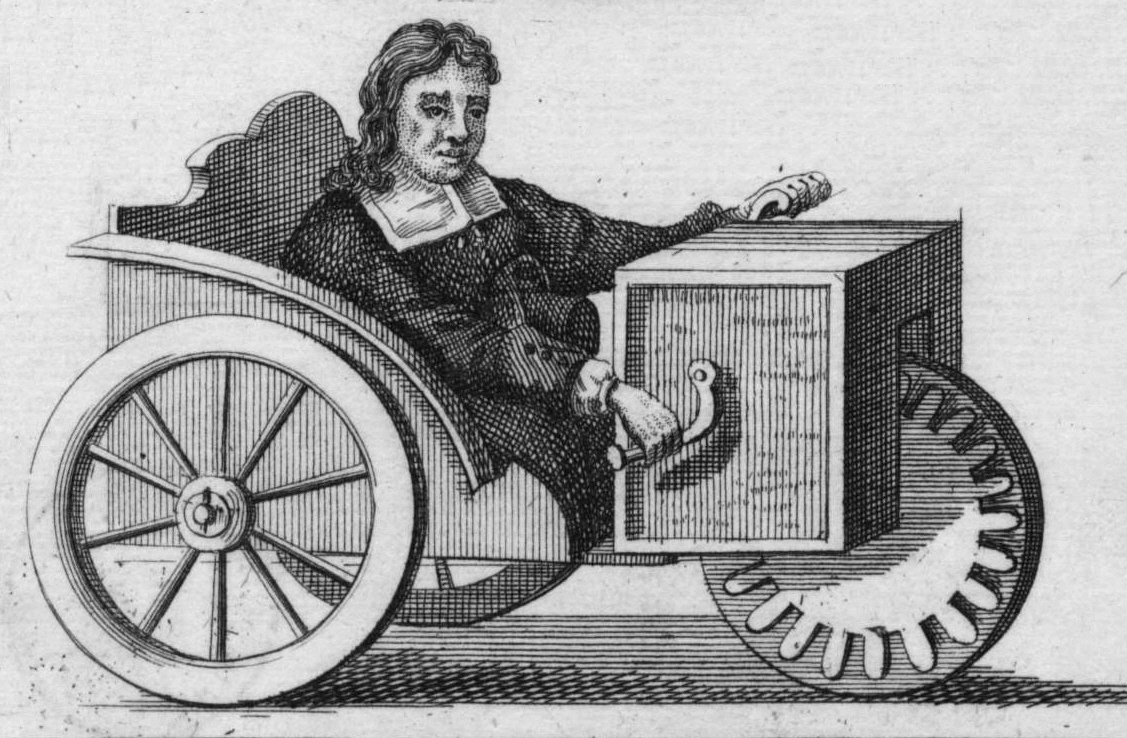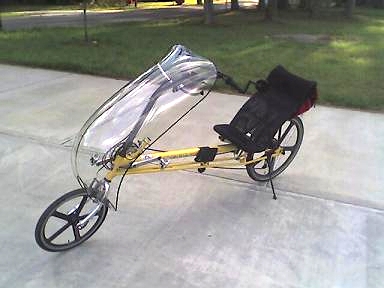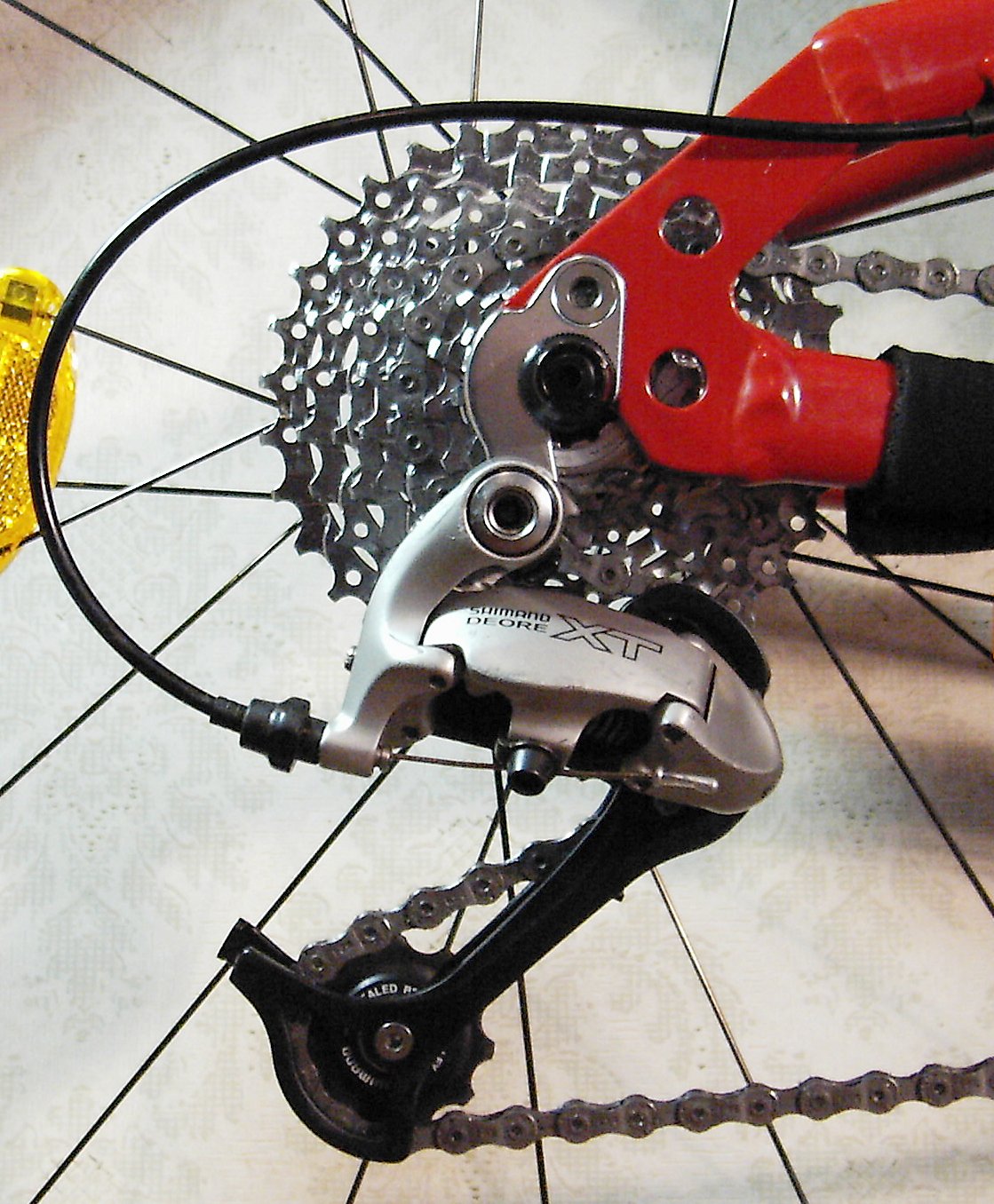|
Tricycle
A tricycle, sometimes abbreviated to trike, is a human-powered (or gasoline or electric motor powered or assisted, or gravity powered) three-wheeled vehicle. Some tricycles, such as cycle rickshaws (for passenger transport) and freight trikes, are used for commercial purposes, especially in the developing world, particularly Africa and Asia. In the West, adult-sized tricycles are used primarily for recreation, shopping, and exercise. Tricycles are favoured by children and senior adults for their apparent stability versus a bicycle; however a conventional trike has poor dynamic lateral stability, and the rider must take care when cornering to avoid tipping the trike over. Unconventional designs such as recumbents have a lower centre of gravity so require less care. History A three-wheeled wheelchair was built in 1655 or 1680 by a disabled German man, Stephan Farffler, who wanted to be able to maintain his mobility. A watch-maker, Farffler created a vehicle that was powe ... [...More Info...] [...Related Items...] OR: [Wikipedia] [Google] [Baidu] |
Recumbents
A recumbent bicycle is a bicycle that places the rider in a laid-back reclining position. Most recumbent riders choose this type of design for ergonomic reasons: the rider's weight is distributed comfortably over a larger area, supported by back and buttocks. On a traditional upright bicycle, the body weight rests entirely on a small portion of the sitting bones, the feet, and the hands. Most recumbent models also have an aerodynamic advantage; the reclined, legs-forward position of the rider's body presents a smaller frontal profile. A recumbent holds the world speed record for a bicycle, and they were banned from racing under the Union Cycliste Internationale (UCI) in 1934, and now race under the banner of the World Human Powered Vehicle Association (WHPVA) and International Human Powered Vehicle Association (IHPVA). Recumbents are available in a wide range of configurations, including: long to short wheelbase; large, small, or a mix of wheel sizes; overseat, underseat, ... [...More Info...] [...Related Items...] OR: [Wikipedia] [Google] [Baidu] |
Three-wheeler
A three-wheeler is a vehicle with three wheels. Some are motorized tricycles, which may be legally classed as motorcycles, while others are tricycles without a motor, some of which are human-powered vehicles and animal-powered vehicles. Overview Many three-wheelers which exist in the form of motorcycle-based machines are often called trikes and often have the front single wheel and mechanics similar to that of a motorcycle and the rear axle similar to that of a car. Often such vehicles are owner-constructed using a portion of a rear-engine, rear-drive Volkswagen Beetle in combination with a motorcycle front end. Other trikes include that are specially constructed for off-road use. Three-wheelers can have either one wheel at the back and two at the front (2F1R), (for example: Morgan Motor Company) or one wheel at the front and two at the back (1F2R) (such as the Reliant Robin). Due to better safety when braking, an increasingly popular form is the front-steering "tadpol ... [...More Info...] [...Related Items...] OR: [Wikipedia] [Google] [Baidu] |
Cycle Rickshaw
The cycle rickshaw is a small-scale local means of transport. It is a type of hatchback tricycle designed to carry passengers on a for-hire basis. It is also known by a variety of other names such as bike taxi, velotaxi, pedicab, bikecab, cyclo, beca, becak, trisikad, sikad, tricycle taxi, trishaw, or hatchback bike. As opposed to rickshaws pulled by a person on foot, cycle rickshaws are human-powered by pedaling. Another type of rickshaw is the auto rickshaw. Overview The first cycle rickshaws were built in the 1880s, and they were first used widely in 1929 in Singapore. Six years later they outnumbered pulled rickshaws. By 1950 cycle rickshaws were found in every south and east Asian country. By the late 1980s there were an estimated 4 million cycle rickshaws in the world. The vehicle is generally pedal-driven by a driver, though some are equipped with an electric motor to assist the driver. The vehicle is usually a tricycle, though some quadracycle models exist, an ... [...More Info...] [...Related Items...] OR: [Wikipedia] [Google] [Baidu] |
Bicycle Drivetrain Systems
Bicycle drivetrain systems are used to transmit power on bicycles, tricycles, quadracycles, unicycles, or other human-powered vehicles from the riders to the drive wheels. Most also include some type of a mechanism to convert speed and torque via gear ratios. History The history of bicycle drivetrain systems is closely linked to the history of the bicycle. Major changes in bicycle form have often been initiated or accompanied by advances in drivetrain systems. Several early drivetrains used straight-cut gears that meshed directly with each other outside of the hub. Some bicycles have used a double-sided rear wheel, with different-sized sprockets on each side. To change gears, the rider would stop and dismount, remove the rear wheel and reinstall it in the reverse direction. Derailleur systems were first developed in the late 19th century, but the modern cable-operated parallelogram derailleur was invented in the 1950s. * Draisine * Penny-farthing * Safety bicycle Power ... [...More Info...] [...Related Items...] OR: [Wikipedia] [Google] [Baidu] |
James Starley
James Starley (21 April 1830 – 17 June 1881) was an English inventor and father of the bicycle industry. He was one of the most innovative and successful builders of bicycles and tricycles. His inventions include the differential gear and the perfection of the bicycle chain drive. Childhood Starley was born in 1830 at Albourne, West Sussex,The Bicycle, UK, 4 November 1953, p8 the son of Daniel Starley, a farmer. He began working on the farm at nine, showing early talent as an inventor by making a rat trap from an umbrella rip and a branch of a willow tree. He ran away from home as a teenager and went to Lewisham, in south London. There he worked as an under-gardener, in his spare time mending watches and creating devices such as a mechanism to allow a duck to get through a hole in a fence, closing a door behind it if a rat tried to follow. Adult life Starley's employer, John Penn, bought a rare and expensive sewing machine. Starley mended it when it broke down and impro ... [...More Info...] [...Related Items...] OR: [Wikipedia] [Google] [Baidu] |
Stephan Farffler
Stephan Farffler (1633 – October 24, 1689), sometimes spelled Stephan Farfler, was a German watchmaker of the seventeenth century whose invention of a manumotive carriage in 1655 is widely considered to have been the first self-propelled wheelchair. The three-wheeled device is also believed to have been a precursor to the modern-day tricycle and bicycle. Farffler, who was either a paraplegic or an amputee, also created a device for turning an hourglass An hourglass (or sandglass, sand timer, sand clock or egg timer) is a device used to measure the passage of time. It comprises two glass bulbs connected vertically by a narrow neck that allows a regulated flow of a substance (historically sand) ... at regular intervals and added chimes to the clocktower of Altdorf bei Nürnberg. the German WiKi says: either paraplegic as a result of an accident when aged three years; others describe him as a human with crippled legs Fabian Zilliken: ''Die Evolution des Fahrrads - Von der ... [...More Info...] [...Related Items...] OR: [Wikipedia] [Google] [Baidu] |
Bicycle Wheel
A bicycle wheel is a wheel, most commonly a wire wheel, designed for a bicycle. A pair is often called a wheelset, especially in the context of ready built "off the shelf" performance-oriented wheels. Bicycle wheels are typically designed to fit into the frame and fork via dropouts, and hold bicycle tires. Invention The first wheel to use the tension in metal spokes was invented by Sir George Cayley to achieve lightness in his 1853 glider. Construction The first bicycle wheels followed the traditions of carriage building: a wooden hub, a fixed steel axle (the bearings were located in the fork ends), wooden spokes and a shrink fitted iron tire. A typical modern wheel has a metal hub, wire tension spokes and a metal or carbon fiber rim which holds a pneumatic rubber tire. Hub A hub is the center part of a bicycle wheel. It consists of an axle, bearings and a hub shell. The hub shell typically has two machined metal flanges to which spokes can be attached. Hub shells ... [...More Info...] [...Related Items...] OR: [Wikipedia] [Google] [Baidu] |
Bicycle Tire
A bicycle tire is a tire that fits on the wheel of a bicycle or similar vehicle. These tires may also be used on tricycles, wheelchairs, and handcycles, frequently for racing. Bicycle tires provide an important source of suspension, generate the lateral forces necessary for balancing and turning, and generate the longitudinal forces necessary for propulsion and braking. Although the use of a pneumatic tire greatly reduces rolling resistance compared to the use of a rigid wheel or solid tire, the tires are still typically, the second largest source, after wind resistance (air drag), of power consumption on a level road. The modern detachable pneumatic bicycle tire contributed to the popularity and eventual dominance of the safety bicycle. Bicycle tires are also used on unicycles, tricycles, quadracycles, tandem bicycles, hand cycles, bicycle trailers, and trailer bikes. History The first bicycle "tires" were iron bands on the wooden wheels of velocipedes. These ... [...More Info...] [...Related Items...] OR: [Wikipedia] [Google] [Baidu] |
Edmund Payne
Edmund James "Teddy" Payne (14 December 1863 – 15 July 1914), was an English actor, comedian and singer best known for creating comic roles in a series of extremely successful Edwardian musical comedies. He was often paired with the comic actor George Grossmith, Jr. After about a decade touring and in stock productions, Payne joined the company at the Gaiety Theatre in London, gaining notice for creating a comic character in the musical '' In Town'' (1892). He spent more than two decades at the Gaiety, using his diminutive stature, malleable features, distinctive lisp and comic dance ability to his advantage. His further successes in the 1890s included lovable comic roles in such long-running shows as ''The Shop Girl'' (1894), '' The Circus Girl'' (1896) and '' A Runaway Girl'' (1898). In the new century, he created memorable characters in such hits as '' The Messenger Boy'' (1900), '' The Toreador'' (1902), '' The Orchid'' (1903), ''The Spring Chicken'' (1905), '' The Gi ... [...More Info...] [...Related Items...] OR: [Wikipedia] [Google] [Baidu] |
Freight
Cargo consists of bulk goods conveyed by water, air, or land. In economics, freight is cargo that is transported at a freight rate for commercial gain. ''Cargo'' was originally a shipload but now covers all types of freight, including transport by rail, van, truck, or intermodal container. The term cargo is also used in case of goods in the cold-chain, because the perishable inventory is always in transit towards a final end-use, even when it is held in cold storage or other similar climate-controlled facility. The term freight is commonly used to describe the movements of flows of goods being transported by any mode of transportation. Multi-modal container units, designed as reusable carriers to facilitate unit load handling of the goods contained, are also referred to as cargo, especially by shipping lines and logistics operators. Similarly, aircraft ULD boxes are also documented as cargo, with an associated packing list of the items contained within. When empty co ... [...More Info...] [...Related Items...] OR: [Wikipedia] [Google] [Baidu] |
Bicycle
A bicycle, also called a pedal cycle, bike or cycle, is a human-powered or motor-powered assisted, pedal-driven, single-track vehicle, having two wheels attached to a frame, one behind the other. A is called a cyclist, or bicyclist. Bicycles were introduced in the 19th century in Europe. By the early 21st century, more than 1 billion were in existence. These numbers far exceed the number of cars, both in total and ranked by the number of individual models produced. They are the principal means of transportation in many regions. They also provide a popular form of recreation, and have been adapted for use as children's toys, general fitness, military and police applications, courier services, bicycle racing, and bicycle stunts. The basic shape and configuration of a typical upright or "safety bicycle", has changed little since the first chain-driven model was developed around 1885. However, many details have been improved, especially since the advent of modern ... [...More Info...] [...Related Items...] OR: [Wikipedia] [Google] [Baidu] |
Bike Boom
The bike boom or bicycle craze is any of several specific historic periods marked by increased bicycle enthusiasm, popularity, and sales. Prominent examples include 1819 and 1868, as well as the decades of the 1890s and 1970sthe latter especially in North Americaand the 2010s in the United Kingdom. 1819 The first period which may be called a bicycle craze actually refers to a precursor of the bicycle which was propelled by being pushed along with the feet as the rider straddled the contraption, and had no pedals. This machine was invented by Baron Karl von Drais in Germany, and was called variously a "draisine" (English) or "draisienne" (French) after his name, a "velocipede" from the Latin terms for "fast foot", a "hobby horse", or a " dandy horse", the last name being perhaps the most popular. Drais got a patent for his invention in 1818, and the craze swept Europe and the United States during the summer of 1819 while many manufacturers (notably Denis Johnson of London ... [...More Info...] [...Related Items...] OR: [Wikipedia] [Google] [Baidu] |










